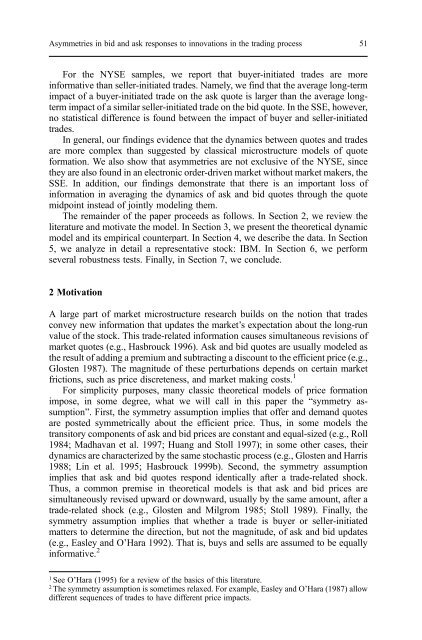recent developments in high frequency financial ... - Index of
recent developments in high frequency financial ... - Index of
recent developments in high frequency financial ... - Index of
Create successful ePaper yourself
Turn your PDF publications into a flip-book with our unique Google optimized e-Paper software.
Asymmetries <strong>in</strong> bid and ask responses to <strong>in</strong>novations <strong>in</strong> the trad<strong>in</strong>g process 51<br />
For the NYSE samples, we report that buyer-<strong>in</strong>itiated trades are more<br />
<strong>in</strong>formative than seller-<strong>in</strong>itiated trades. Namely, we f<strong>in</strong>d that the average long-term<br />
impact <strong>of</strong> a buyer-<strong>in</strong>itiated trade on the ask quote is larger than the average longterm<br />
impact <strong>of</strong> a similar seller-<strong>in</strong>itiated trade on the bid quote. In the SSE, however,<br />
no statistical difference is found between the impact <strong>of</strong> buyer and seller-<strong>in</strong>itiated<br />
trades.<br />
In general, our f<strong>in</strong>d<strong>in</strong>gs evidence that the dynamics between quotes and trades<br />
are more complex than suggested by classical microstructure models <strong>of</strong> quote<br />
formation. We also show that asymmetries are not exclusive <strong>of</strong> the NYSE, s<strong>in</strong>ce<br />
they are also found <strong>in</strong> an electronic order-driven market without market makers, the<br />
SSE. In addition, our f<strong>in</strong>d<strong>in</strong>gs demonstrate that there is an important loss <strong>of</strong><br />
<strong>in</strong>formation <strong>in</strong> averag<strong>in</strong>g the dynamics <strong>of</strong> ask and bid quotes through the quote<br />
midpo<strong>in</strong>t <strong>in</strong>stead <strong>of</strong> jo<strong>in</strong>tly model<strong>in</strong>g them.<br />
The rema<strong>in</strong>der <strong>of</strong> the paper proceeds as follows. In Section 2, we review the<br />
literature and motivate the model. In Section 3, we present the theoretical dynamic<br />
model and its empirical counterpart. In Section 4, we describe the data. In Section<br />
5, we analyze <strong>in</strong> detail a representative stock: IBM. In Section 6, we perform<br />
several robustness tests. F<strong>in</strong>ally, <strong>in</strong> Section 7, we conclude.<br />
2 Motivation<br />
A large part <strong>of</strong> market microstructure research builds on the notion that trades<br />
convey new <strong>in</strong>formation that updates the market’s expectation about the long-run<br />
value <strong>of</strong> the stock. This trade-related <strong>in</strong>formation causes simultaneous revisions <strong>of</strong><br />
market quotes (e.g., Hasbrouck 1996). Ask and bid quotes are usually modeled as<br />
the result <strong>of</strong> add<strong>in</strong>g a premium and subtract<strong>in</strong>g a discount to the efficient price (e.g.,<br />
Glosten 1987). The magnitude <strong>of</strong> these perturbations depends on certa<strong>in</strong> market<br />
frictions, such as price discreteness, and market mak<strong>in</strong>g costs. 1<br />
For simplicity purposes, many classic theoretical models <strong>of</strong> price formation<br />
impose, <strong>in</strong> some degree, what we will call <strong>in</strong> this paper the “symmetry assumption”.<br />
First, the symmetry assumption implies that <strong>of</strong>fer and demand quotes<br />
are posted symmetrically about the efficient price. Thus, <strong>in</strong> some models the<br />
transitory components <strong>of</strong> ask and bid prices are constant and equal-sized (e.g., Roll<br />
1984; Madhavan et al. 1997; Huang and Stoll 1997); <strong>in</strong> some other cases, their<br />
dynamics are characterized by the same stochastic process (e.g., Glosten and Harris<br />
1988; L<strong>in</strong> et al. 1995; Hasbrouck 1999b). Second, the symmetry assumption<br />
implies that ask and bid quotes respond identically after a trade-related shock.<br />
Thus, a common premise <strong>in</strong> theoretical models is that ask and bid prices are<br />
simultaneously revised upward or downward, usually by the same amount, after a<br />
trade-related shock (e.g., Glosten and Milgrom 1985; Stoll 1989). F<strong>in</strong>ally, the<br />
symmetry assumption implies that whether a trade is buyer or seller-<strong>in</strong>itiated<br />
matters to determ<strong>in</strong>e the direction, but not the magnitude, <strong>of</strong> ask and bid updates<br />
(e.g., Easley and O’Hara 1992). That is, buys and sells are assumed to be equally<br />
<strong>in</strong>formative. 2<br />
1 See O’Hara (1995) for a review <strong>of</strong> the basics <strong>of</strong> this literature.<br />
2 The symmetry assumption is sometimes relaxed. For example, Easley and O’Hara (1987) allow<br />
different sequences <strong>of</strong> trades to have different price impacts.










